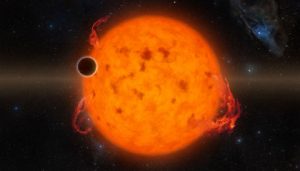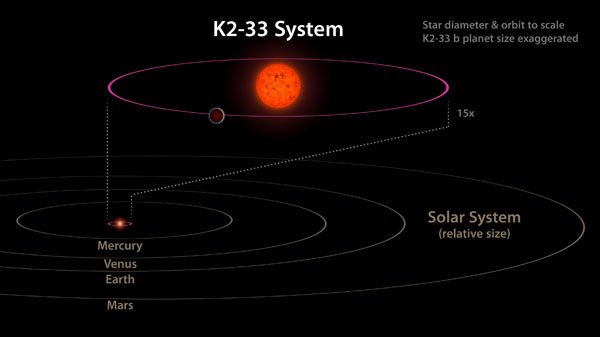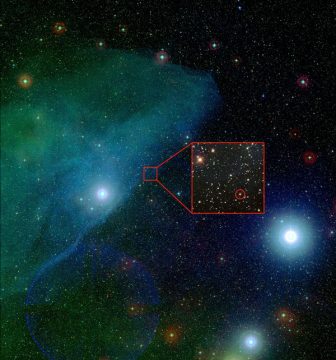A recent glut of exoplanet research reveals the early chaos that helped shape planetary systems.

NASA / JPL-Caltech
Our tidy, ordered solar system gives us a false impression of calm. The planets’ orbits are relatively steady today, but they were far from stable in our system’s early years.
Chaos is the rule of planetary systems, with multiple planets shifting orbits and even trading places over cosmic timescales. But the question has long been posed: when and how do these chaos occur?
Recent research suggests the answer is sooner rather than later — discoveries of two newborn planets by three independent teams points to the mechanism behind early planetary migration.
How to Move a Planet
The planets jostle for position on the path to planethood, and nowhere is migration more certain than in the case of hot Jupiters and hot Neptunes — these gas giant planets would have a hard time forming so close to their host stars, so they probably formed beyond the ice line and then migrated inward.
Assuming Superman’s not around, the only way a planet can change its orbit is to grant speed (well, technically, angular velocity) to another body via gravitational interactions. But what that third body is, is up for debate: suggestions have included planet-planet scattering, interplay with a second star, or interactions with the primordial gas disk that the planet formed in.
While the first two mechanisms probably take more than 100 million years, the latter happens quickly, within a couple million years. With that realization, researchers set off in search for young planets around young stars. But it’s a trickier proposition than it sounds: stellar youngsters flicker more than their elders, and they’re plagued with spots that mimic temporary transiting planets. But in the past two weeks, astronomers have met with success.
A Duo of Newborn Planets

NASA / JPL-Caltech
Two independent teams recently announced the discovery of planet K2-33b, a gas giant bigger and more massive than Neptune that orbits its red dwarf host star every 5.4 days. Mercury orbits our Sun from a distance of roughly 0.4 astronomical units (a.u.) — this super-Neptune circles its star ten times closer at only 0.04 a.u. The planet was initially spotted using the Kepler spacecraft as it continues its K2 mission.
The discovery of a super-Neptune, even one on a close-in orbit, would hardly be worth mentioning in this era of exoplanets but for the youth of its star. K2-33 lives almost 500 light-years away in the Upper Scorpius star-forming region. It’s roughly 10 million years old — too young for most migration mechanisms to work. There are only two ways the super-Neptune could have arrived at its current orbit: either it formed where it is — unlikely, but still possible — or it migrated there by interacting gravitationally with the gas disk.

A. Mann / McDonald Observatory / Background: Digitized Sky Survey; Inset: Sloan Digital Sky Survey
The team led by Trevor David (Caltech) announced their discovery in the June 20th Nature, including follow-up spectroscopy taken with the Keck-I telescope. The Kepler observations helped pinpoint the planet’s size at 5.8 times the span of Earth, while the Keck observations showed the host star’s wiggle in response to its planet’s gravitational tug was undetectable, making the planet no more than 3.6 times the mass of Jupiter, but probably much lighter.
Andrew Mann (University of Texas, Austin) led an independent team that reports the K2 discovery along with extended observations of the transiting planet from the MEarth project in an upcoming issue of Astronomical Journal (preprint available here). The measurements tweak the planet’s radius, putting its span at just five times Earth’s.
“Both of these studies are really neat,” says Daniel Fabrycky (University of Chicago). “The discovery of a transiting planet around a young star is something we've all been hoping for!”
Meanwhile, Jean-François Donati (University of Toulouse, France) and colleagues announced another discovery, also published in the June 20th Nature: a hot Jupiter orbiting a stellar infant, the 2 million-year-old V830 Tauri. This second close-in gas giant around an even younger star strengthens the case for migration through the disk.

J.F. Donati et al.
Evidence from Exoplanet Resonance
Yet another straw on the camel’s back comes from Kepler 223, a 6 billion-year-old Sun-like star that hosts four super-Neptunes, each one seen in transit across the face of the star. Sean Mills (University of Chicago) and colleagues showed in the May 26th Nature that the planets circle their star in resonant orbits, that is, orbits that are multiples of one another. Such a configuration is difficult to explain unless — you guessed it — the planets migrated to their current positions by disk interactions.
But to put the final nail in the coffin of alternative migration theories, astronomers need just a little bit more data. If despite all odds, planet-planet or planet-star interactions still want to claim credit for the newborn planets’ current positions, then astronomers should spot an oval shape to their orbits, or even an overall tilt. None of the studies on K2-33 or V830 Tau constrain the planets’ orbits in that sense, so stay tuned for future observations.
 1
1
Comments
Bob
July 1, 2016 at 7:04 pm
Very interesting article. Excellent images.
You must be logged in to post a comment.
You must be logged in to post a comment.